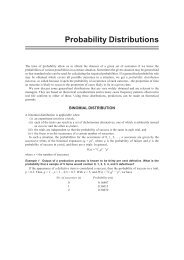International-Business-Dr-R-Chandran-E-book
International-Business-Dr-R-Chandran-E-book
International-Business-Dr-R-Chandran-E-book
Create successful ePaper yourself
Turn your PDF publications into a flip-book with our unique Google optimized e-Paper software.
224<br />
<strong>International</strong> <strong>Business</strong>- <strong>Dr</strong>. R. <strong>Chandran</strong><br />
However, it is important to understand, interpret and modify these concepts<br />
and apply them to current practices in business, especially the functions of<br />
labour productivity, resource exploration and demand forecasting.<br />
THE THEORY OF ABSOLUTE ADVANTAGE<br />
The classical theories of international trade that were propounded by Adam<br />
Smith, David Ricardo, John Stuart Mill and others were based mainly on<br />
differences in the cost of labour between different nations. Among the<br />
classical theories, the most discussed theory was the theory of ‘Absolute<br />
Advantages’ put forward by Adam Smith, which was widely accepted and<br />
relevant during his contemporary era.<br />
Adam Smith was a champion of free trade and he claimed that free trade<br />
always leads to better division of labour and thereby encourages<br />
specialization both in national and international markets. He advocated that<br />
every country is specialized in certain production function and ultimately<br />
will be able to enjoy the benefits. Countries can exchange the products they<br />
produce at a lower cost with each other. He remarked that, “it is the wise<br />
decision of every prudent master never to make goods at home, which will<br />
cost him more, but to buy them, which is cheaper”. For example a cobbler<br />
does not attempt to make his own shoe, but he buys them from the<br />
shoemaker and vice versa. An individual select the occupation for which he<br />
thinks himself best fitted. Similarly, every country tries to specialise in the<br />
production of those commodities, in which it enjoys greater advantages e.g,<br />
Malta produces glass. China produces soft toys, South Korea produces<br />
synthetic fibres, and India produces metal ware and Myanmar produces good<br />
quality timber,<br />
The theory of absolute advantage can be explained with the help of an<br />
example, consider two countries A and B, each in which produces two<br />
different types of goods, namely X and Y. With one unit of labour, country<br />
A can produce either 20 units of commodity X or 10 units of commodity Y.<br />
On the other hand, with one unit of labour, country B can produce either 10<br />
units of X or 20 units of Y. This clearly shows that country A has an<br />
absolute advantage in the production of goods of the type X and country B<br />
has an absolute advantage in the production of goods of the type Y. In this<br />
case, trade between countries A and B will be mutually beneficial, as with<br />
two units of labour, A can produce 40 units of X and B can produce 40 units<br />
of Y, i.e 80 units of X and Y between them. On the other hand without<br />
international trade, they can produce only 60 units of X and Y between them<br />
with the same amount of labour. Thus country A should specialize in the<br />
Only for Private Circulation





